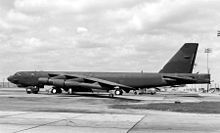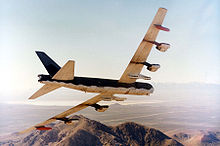| 379th Air Expeditionary Wing | |
|---|---|
 379th Air Expeditionary Wing emblem | |
| Active | 1953-Present |
| Country | United States |
| Branch | United States Air Force |
| Type | Air Expeditionary |
| Role | Various |
| Garrison/HQ | Al Udeid Air Base, Qatar |
| Motto(s) | DILIGENTIA ET ACCURATIO - Precision and accuracy |
| Engagements | Operation Desert Storm; Operation Enduring Freedom; Operation Iraqi Freedom |
| Commanders | |
| Current commander | Brig. General Stephen W. Wilson |
| Notable commanders | Eugene E. Habiger |
The 379th Air Expeditionary Wing (379 AEW) is a provisional United States Air Force unit assigned to Air Combat Command. As a provisional unit, it may be activated or inactivated at any time.
The Wing is one of the largest, most diverse expeditionary wings in the Air Force, providing combat airpower and support for the Global War on Terrorism in Operations Iraqi Freedom, Enduring Freedom and through support of Combined Joint Task Force - Horn of Africa. The wing and its associate units operate more than 100 aircraft, making the base a large hub for humanitarian airlift activity while providing mission-essential combat power, aeromedical evacuation and intelligence support for three theaters of operations.
During World War II, the Wing's predecessor unit, the 379th Bombardment Group was a VIII Bomber Command B-17 Flying Fortress unit in England. Assigned to RAF Kimbolton in early 1943, the group flew more sorties than any other bomb group in the Eighth Air Force, and dropped a greater bomb tonnage than any other group. The combat record of the 379th was the most successful of all the Eighth Air Force heavy bomber groups, receiving two Distinguished Unit Citations. Active for over 50 years, the 96th Bombardment Wing was a component organization of Strategic Air Command's deterrent force during the Cold War, as a strategic bombardment wing.
Units



- 379th Expeditionary Operations Group
- 7th Expeditionary Airborne Command and Control Squadron
- 71st Expeditionary Air Control Squadron
- 340th Expeditionary Air Refueling Squadron
- 379th Expeditionary Aeromedical Evacuation Squadron
- 379th Expeditionary Operations Support Squadron
- 746th Expeditionary Airlift Squadron
- 763d Expeditionary Reconnaissance Squadron
- 379th Expeditionary Maintenance Group
- 379th Expeditionary Aircraft Maintenance Squadron
- 379th Expeditionary Maintenance Squadron
- 379th Expeditionary Maintenance Operations Squadron
- 379th Expeditionary Mission Support Group
- 379th Expeditionary Civil Engineer Squadron
- 379th Expeditionary Security Forces Squadron
- 379th Expeditionary Communications Squadron
- 64th Air Expeditionary Group
- 8th Expeditionary Air Mobility Squadron
Aircraft Assigned
- KC-135R (2003-Present)
- F-15C (2003-2006)
- KC-10A (2003-Present)
- C-130H (2003-Present)
- C-130J-30 (2009-Present)
- B-1B (2007-Present)
--8 EAMS--
- C-17A (2006-Present)
History
- For additional history and lineage, see 379th Air Expeditionary Operations Group
Lineage
- Established as 379th Bombardment Wing, Medium, on 23 Mar 1953
- Activated on 1 Nov 1955
- Redesignated 379th Bombardment Wing, Heavy, on 9 Jan 1961
- Inactivated on 30 Jun 1993.
- Redesignaetd 379th Air Expeditionary Wing and converted to provisional status on 4 Dec 2001
Assignments
- Second Air Force, 1 Nov 1955
- Attached to 813th Air Division, 1 Nov 1955-31 May 1956
- 823d Air Division, 1 Jun 1956
- Attached to 5th Air Division, 6 Mar-12 May 1957
- 40th Air Division, 9 Jan 1961
- Strategic Air Command, 8 Jun 1988
- Ninth Air Force, 1 Jun 1992-1339
- Air Combat Command to activate or inactivate any time after 4 Dec 2001.
Components
- 19th Air Refueling Squadron, 1 Feb-30 Jun 1956 (Attached)
- 524th Bombardment Squadron, 1 Nov 1955-15 Jun 1993
- 525th Bombardment Squadron, 1 Nov 1955-9 Jan 1961
- 526th Bombardment Squadron, 1 Nov 1955-9 Jan 1961
- 527th Bombardment Squadron, 1 Nov 1955-9 Jan 1961
- 920th Air Refueling Squadron, 9 Jan 1961-15 Jun 1993
Stations
- Homestead AFB, Florida, 1 Nov 1955
- Wurtsmith AFB, Michigan, 9 Jan 1961-30 Jun 1993
Aircraft
- KC-97, 1956
- B-47, 1956-1960
- B-52, 1961-1993
- KC-135, 1961-1993
Cold War

The wing was reactivated as the 379th Bombardment Wing (Medium) on November 1, 1955 at Homestead Air Force Base in Florida (replacing the 4276th Air Base Squadron). From November 1, 1955 to May 31, 1956 the unit was attached to the 813th Air Division at Pinecastle Air Force Base, Florida. It's operational squadrons were the 524th, 525th 526th and 527th Bomb Squadrons. Upon activation, the unit was bestowed the honors, history and colors of the World War II Eighth Air Force 379th Bomb Group.
In April 1956, the wing began training for air refueling and strategic bombardment operations with the B-47E and KC-97G. It was an assigned unit to the 823d Air Division at Homestead Air Force Base, Florida, from June 1, 1956 to January 9, 1961. During this time, the wing was attached to Sidi Slimane, 5th Air Division, French Morocco, from March 6 to May 12 of 1957 during a REFLEX deployment. Beginning in October 1960, the wing began transferring its B-47s to other SAC wings.
The 379th was reassigned to Wurtsmith Air Force Base, Michigan without personnel or equipment in January, 1961, being assigned to the 40th Air Division. At Wurtsmith, the wing's 524th Bomb Squadron was re-equipped with B-52H and it's 920th ARS received KC-135 aircraft. Once equipped, the wing resumed training for strategic bombardment and air refueling operations. It was redesignated as the 379th Bombardment Wing (Heavy) on 9 January 1961.
Personnel and KC-135 tankers from the 379th were deployed to forward bases in the Pacific to support combat operations from 1965 - 1975, however it's B-52H aircraft remained at Wurthsmith on nuclear alert.
In 1977, the 379th exchanged their B-52Hs for the conventional bomb capable B-52G. In 1989, the Air Force selected Wurtsmith as one of seven bases that would house LGM-118A Peacekeeper ICBM Peacekeeper Rail Garrison. A Rail Garrison would address the survivability problem by which 25 trains, each with two missiles, would use the national railroad system to conceal themselves. It was intended that this system would become operational in late 1992, but budgetary constraints and the changing international situation led to it being scrapped.
Modern Era
Retirement of the B-52G began in the late 1980s, however the Gulf War of 1990-1991 resulted in a temporary delay in the inactivation of B-52G units. Wurtsmith-based B-52s were flown on missions against Iraq staged out of Prince Abdullah AB in Jeddah, Saudi Arabia. These planes were part of the 1708th BW (P), a temporary wing formed from B-52s out of Barksdale, Castle, Wurtsmith, and others. The planes arrived at dawn on the first day of the air war.
One plane flew 29 missions out of Jeddah, the most of any bomber crew in the theater. During the Gulf War, 379th Bomb Wing aircraft carried the "Triangle K" tail flash in honor of their World War II predecessors and heritage.
The 379th Bombardment Wing was inactivated on June 30, 1993 as a result of the 1991 Base Realignment and Closure process which closed Wurtsmith AFB. On the overcast foggy morning of December 15, 1992, the last B-52, 57-6492, Old Crow Express, was flown to Davis-Monthan Air Force Base.
Awards
- Air Force Outstanding Unit Award (for the period July 1, 1970 to June 30, 1971)
- Omaha Trophy for the best aircraft or missile organization in the Strategic Air Command
- Commander in Chief, Strategic Air Command, Flying Wing of the Year Award (1971)
- SAC Charles D. Trail Materiel Award
- Second Air Force Sweeney Award
- Second Air Force Martensen Award
- Fairchild Trophy for the best strategic bombardment wing in SAC (1987)
- SAC Proud Shield bombing and navigation competition (1987)
- Air Force Meritorious Unit Award (for the periods September 1, 2003 to May 31, 2004, and June 1, 2005 to May 31, 2006)
References
![]() This article incorporates public domain material from the Air Force Historical Research Agency
This article incorporates public domain material from the Air Force Historical Research Agency
- Ravenstein, Charles A. (1984). Air Force Combat Wings Lineage and Honors Histories 1947-1977. Maxwell AFB, Alabama: Office of Air Force History. ISBN 0912799129.
- 379 AEW USAFHRA FOI Release
External links
- Official site
- Official blog
- 379th Air Expeditionary Wing on X
- 379th Air Expeditionary Wing at GlobalSecurity.org
- 379th Bombardment Wing at WAFB.NET
| Air Forces | |||||||||
|---|---|---|---|---|---|---|---|---|---|
| Centers | |||||||||
| Bases | |||||||||
| Wings |
| ||||||||

